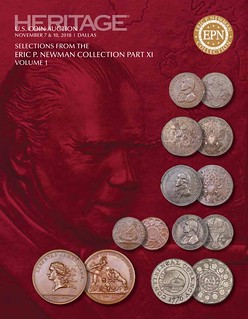
PREV ARTICLE
NEXT ARTICLE
FULL ISSUE
PREV FULL ISSUE
NEWMAN SALE XI VOLUME 1 COIN HIGHLIGHTSHere are some highlights from the upcoming two-volume Heritage sale XI of the Eric P. Newman collection. -Editor Volume 1:
Lot 15002: 1776 Continental Dollar, CURENCY, Pewter 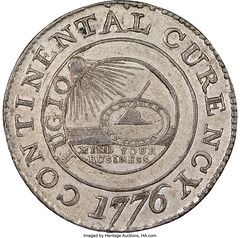 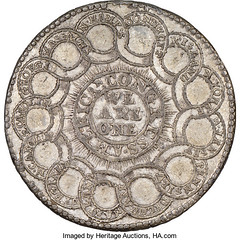 1776 $1 Continental Dollar, CURENCY, Pewter AU55 NGC. Newman 1-B, Breen-1086, Hodder 1-A.2, W-8435, High R.7. Pewter examples of the 1-B variety were unknown to Eric P. Newman in 1953. They are considerably rarer than brass examples of the variety, which makes this Choice About Uncirculated pewter example an important opportunity for Colonial specialists. We know of just six surviving coins struck in pewter from the 1-B die pair. In comparison, more than a dozen brass strikings are known from the 1-B dies. The 1-B variety shares its obverse with the 1-C. Only a few distinguishing features separate the two varieties. In its early die state, the 1-C obverse is nearly identical to 1-B, although later states show a diagnostic die crack above GIO in FUGIO. The reverse of the 1-B shows crude reworking of the die to strengthen the linked circles, which were previously formed from a series of disconnected dots as seen on the 1-A variety. On 1-B, traces of the original dots remain clearly visible along the edges of the now-solid rings. Die lapping and additional die reworking on 1-C altogether eliminates the dots. Rays outside the center ring near RESS of CONGRESS come fully formed on Newman 1-B, but they are often attenuated on 1-C in mid-to-late die states. A pellet-like die chip near the Pennsylvania ring center of this 1-B is clear to the unaided eye, a feature that is absent on 1-C examples. While the origin and purpose of the 1776 Continental dollar has long been an intriguing topic of discussion among numismatists and researchers, Eric P. Newman believed that these coins were American-made. Further, the fact that the Continental Currency paper $1 notes were eliminated from the six issues from July 22, 1776, through September 26, 1778, indicates that Congress planned for a $1 coin, and that the Continental dollar was used as fiat money. Multiple varieties of the Continental dollar exist, and varying quantities of coins were struck in pewter, brass, and silver from multiple die combinations and die stages. Today, there are either six or seven pewter Newman 1-B dollars confirmed, depending on the status of the 1968 Merkin coin. To read the complete lot description, see: 1776 $1 Continental Dollar, CURENCY, Pewter AU55 NGC. Newman 1-B, Breen-1086, Hodder 1-A.2, W-8435, High R.7... (https://coins.ha.com/itm/colonials/1776-1-continental-dollar-curency-pewter-au55-ngc-newman-1-b-breen-1086-hodder-1-a2-w-8435-high-r7/a/1283-15002.s) Lot 15009: 1792 Washington Getz Pattern Half Dollar 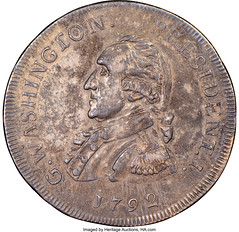  1792 50C Washington Getz Pattern Half Dollar, Small Eagle, Silver, Plain Edge XF45 NGC. Baker-24, W-10780, Musante GW-22, Low R.7. 35.2 x 34.2 mm., 190.3 grains. George Fuld's accounting of silver Getz pattern half dollars in The Washington Pattern Coinage of Peter Getz enumerated just 22 examples of all variants. Those variants include five examples with a Circles and Squares edge, all showing undertype; three examples with the intertwined olive leaves edge and one with a lettered edge, also all showing undertype; four examples with a plain edge that show undertype; and nine examples with a plain edge that have no evidence of undertype, including the piece offered here that Fuld recorded as number four in his list. Seven of the 22 silver Getz pattern half dollars are held in museum collections, including the Smithsonian Institution, the Massachusetts Historical Society, an Austrian museum, the Pennsylvania Historical Society, the Durham Western Heritage Museum, the Museum of Connecticut History, and the Colonial Williamsburg Foundation. Although 13 of the 22 examples are overstruck, showing traces of undertype, it is probably the case that all silver examples were struck over some sort of existing silver coin. The absence of visible die rust on the reverse evidences an early striking. The weight of the Newman specimen is similar to early French half ecus struck before 1726. This pewter-gray example has dappled navy and gold toning on the obverse, and delicate gold and ivory toning on the reverse. The obverse has nearly complete border details, absent only from 11 to 1 o'clock. Reverse border dentils are present from 11 to 4 o'clock. This is an extremely important opportunity to acquire one of the rare Getz pattern half dollars struck in silver. This piece was exhibited at the 1914 American Numismatic Society's Exhibition of U.S. and Colonial Coins. To read the complete lot description, see: 1792 50C Washington Getz Pattern Half Dollar, Small Eagle, Silver, Plain Edge XF45 NGC. Baker-24, W-10780, Musante GW-22, Low... (https://coins.ha.com/itm/colonials/1792-50c-washington-getz-pattern-half-dollar-small-eagle-silver-plain-edge-xf45-ngc-baker-24-w-10780-musante-gw-22-low/a/1283-15009.s) Lot 15007: 1792 Washington Silver Pattern, Lettered Edge 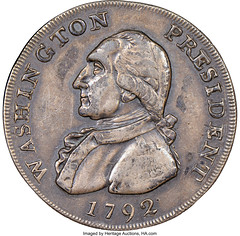 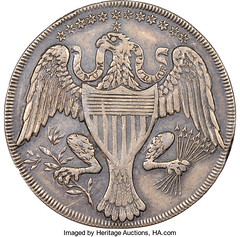 1792 CENT Washington Silver Pattern, Lettered Edge, Baker-20, Breen-1231, Musante GW-31 (B), High R.7 -- Obverse Graffiti -- NGC Details. XF. Ex: Picker. The silver 1792 Washington President, Large Eagle pattern, designated Baker-20, is among the rarest issues in all Washington coinage. Just five examples are known, only three of which are privately owned. The other two coins reside in institutional collections: one in the Massachusetts Historical Society, and the other in the Historical Society of Pennsylvania. The Massachusetts Historical Society coin is arguably the finest piece known. It was donated in June 1905 by the estate of William Sumner Appleton, who was a prominent 19th century collector. The other institutional coin is holed and plugged, and was donated to the Historical Society of Pennsylvania by William S. Baker. Baker is believed to have acquired it in W.E. Woodward's May 1888 sale of the Vicksburg Collection. It was previously the coin owned by A.S. Jenks of Philadelphia, whose collection was auctioned by Edward Cogan in April 1877. The Appleton and Jenks coins were two of four pieces known to Crosby in 1875. In The Early Coins of America, Crosby named Charles I. Bushnell and Lorin G. Parmelee as the owners of two other pieces. Parmelee acquired Bushnell's coin in 1882, and it is that piece which was later sold with Parmelee's collection in June 1890. The Chapman brothers acquired it, and the coin later passed through the collection of "Col." E.H.R. Green, among others, and ended up in the possession of John J. Ford, Jr. It last appeared publicly in Stack's May 2004 sale of the Ford Collection, where it sold for $115,000. The piece Parmelee owned in 1875 was sold or traded prior to 1890. Today, it is either the John L. Roper coin or the Eric P. Newman example. Baker-20 has a lettered edge. Most modern references list a Plain Edge silver variety, designated Baker-20A, but it is our opinion that such a coin does not exist. Our exhaustive study of auction listings going back to the early 1860s fails to reveal any confirmed appearance of a Plain Edge coin, and no such piece is known today. The origin of the so-called Plain Edge silver issue appears to be George Fuld's notes on the variety in the 1965 reprint of Baker's 1885 seminal reference on Washington coins and medals. Fuld states simply that "four or five plain edge" coins are known. Baker's original reference made no mention of a Plain Edge variant. Where Fuld got his information is unknown, although it is possible that the supposed Plain Edge variety was the result of misinterpreting early auction descriptions of silver Getz half dollar patterns as appearances of Baker-20, compounded by the fact that a few early Baker-20 auction listings do not mention the edge lettering. In any case, while copper coins are known with plain and lettered edges, it is believed that silver pieces exist only of the lettered edge type. We are pleased to offer the Newman coin in its first known public auction appearance. NGC denies this piece a numeric grade due to a few faint pinscratches on Washington's portrait and what appears to be a crude letter "D" in the left adjacent field. However, these are virtually undetectable by the naked eye. The toned olive-gray and gunmetal-blue surfaces deliver an old-silver appearance, and the design elements exhibit little wear. The edge lettering is clear. To read the complete lot description, see: 1792 CENT Washington Silver Pattern, Lettered Edge, Baker-20, Breen-1231, Musante GW-31 (B), High R.7 -- Obverse Graffiti (https://coins.ha.com/itm/colonials/1792-cent-washington-silver-pattern-lettered-edge-baker-20-breen-1231-musante-gw-31-b-high-r7-obverse-graffiti-/a/1283-15007.s) Lot 15010: Libertas Americana Medal  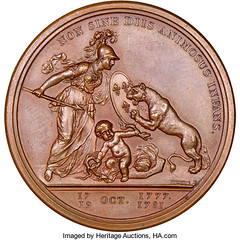 (1781) Medal Libertas Americana Medal MS64 Brown NGC. Betts-615, Loubat-14. It is safe to say that most British loyalists were not pleased by either the design or the intent of Benjamin Franklin's Libertas Americana medal, which extolled the role France played in the American War of Independence while chiding the British for their humiliating defeats at Yorktown and Saratoga. There was no mistaking the symbolic imagery of Minerva (France) protecting the infant Hercules (America) from a rampaging lion (England), while the precocious infant strangled a pair of serpents (Burgoyne and Cornwallis). Meanwhile, dignitaries in France and America could not have been more delighted with the message and the impressive artistry of the medal. Based on a sketch by Esprit-Antoine Gibelin and engraved by Augustin Dupré, the medal was struck at the Paris Mint circa 1781. Page 102 of the 2019 Guide Book estimates that no more than 100 to 125 original bronze medals survive, plus two dozen or slightly more silver pieces. This near-Gem bronze example exhibits even, chocolate-brown surfaces with nearly unmarked, well-preserved, and partially reflective surfaces. A small die defect at the border below the 4 in the date of the obverse exergue confirms this piece as an original strike. Traces of die rust, as struck, are diagnostic of the original medals. The Libertas Americana medal ranks #1 by a wide margin in Jaeger and Bowers' 100 Greatest American Medals and Tokens. To read the complete lot description, see: (1781) Medal Libertas Americana Medal MS64 Brown NGC. Betts-615, Loubat-14.... (https://coins.ha.com/itm/colonials/-1781-medal-libertas-americana-medal-ms64-brown-ngc-betts-615-loubat-14/a/1283-15010.s) To read the complete sale catalog on the Newman Portal, see:  Wayne Homren, Editor The Numismatic Bibliomania Society is a non-profit organization promoting numismatic literature. See our web site at coinbooks.org. To submit items for publication in The E-Sylum, write to the Editor at this address: whomren@gmail.com To subscribe go to: https://my.binhost.com/lists/listinfo/esylum All Rights Reserved. NBS Home Page Contact the NBS webmaster 
|
